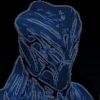I think my issue may relate to interpolating vertex attributes across each triangle, when I calculate the input texture data; I cannot be sure however.
Thanks

//--------------------------------------------------------------------------------------
// Lighting
//--------------------------------------------------------------------------------------
//transformation matrices
matrix World;
matrix View;
matrix Projection;
//TEXTURE VARIABLES
//--------------------------------------------------------------------------------------
//color map texture
Texture2D tex2D;
//bump map texture
Texture2D bump2D;
//texture sampler state
SamplerState linearSampler
{
Filter = min_mag_mip_linear;
AddressU = Wrap;
AddressV = Wrap;
};
//LIGHTING STRUCTURES AND VARIABLES
//--------------------------------------------------------------------------------------
struct DirectionalLight
{
float4 color;
float3 dir;
};
struct Material
{
float Ka, Kd, Ks, A;
};
//lighting vars
DirectionalLight light;
Material material;
float4 ambientLight;
float3 eye;
float4x4 gTexMtx;
//RASTERIZER STATES
//--------------------------------------------------------------------------------------
RasterizerState rsSolid
{
FillMode = Solid;
CullMode = NONE;
FrontCounterClockwise = false;
};
//VERTEX AND PIXEL SHADER INPUTS
//--------------------------------------------------------------------------------------
struct VS_INPUT
{
float4 p : POSITION;
float2 t : TEXCOORD;
float3 n : NORMAL;
float3 tangent : TANGENT;
};
struct PS_INPUT_PP_BLINNPHONG
{
float4 p : SV_POSITION;
float2 t : TEXCOORD;
float3 n : TEXCOORD1;
float3 h : TEXCOORD2;
float3 tangent : TANGENT;
};
//--------------------------------------------------------------------------------------
// Blinn-Phong Lighting Reflection Model
//--------------------------------------------------------------------------------------
float4 calcBlinnPhongLighting( Material M, float4 LColor, float3 N, float3 L, float3 H )
{
float4 Ia = M.Ka * ambientLight;
float4 Id = M.Kd * saturate( dot(N,L) );
float4 Is = M.Ks * pow( saturate(dot(N,H)), M.A );
return Ia + (Id + Is) * LColor;
}
//--------------------------------------------------------------------------------------
// PER PIXEL LIGHTING
//--------------------------------------------------------------------------------------
PS_INPUT_PP_BLINNPHONG VS_PIXEL_LIGHTING_BLINNPHONG( VS_INPUT input )
{
PS_INPUT_PP_BLINNPHONG output;
//set position into clip space
input.p = mul( input.p, World );
output.p = mul( input.p, View );
output.p = mul( output.p, Projection );
//set texture coords
output.t = input.t;
// Output vertex attributes for interpolation across triangle.
//output.t = mul(float4(input.t, 0.0f, 1.0f), gTexMtx);
//set required lighting vectors for interpolation
float3 V = normalize( eye - (float3) input.p );
output.n = normalize( mul(float4(input.n, 0.0f ), World) );
output.h = normalize( -light.dir + V );
// Calculate the tangent vector against the world matrix only and then normalize the final value.
//output.tangent = mul(input.tangent, (float3x3)World);
output.tangent = mul(float4(input.tangent, 0.0f), World);
output.tangent = normalize(output.tangent);
return output;
}
float4 PS_PIXEL_LIGHTING_BLINNPHONG( PS_INPUT_PP_BLINNPHONG input ) : SV_Target
{
//renormalize interpolated vectors
input.n = normalize( input.n );
input.h = normalize( input.h );
//calculate lighting
float4 I = calcBlinnPhongLighting( material, light.color, input.n, -light.dir, input.h );
//with texturing
return I * tex2D.Sample(linearSampler, input.t);
}
float4 PS_NORMAL_MAP( PS_INPUT_PP_BLINNPHONG input) : SV_Target
{
float4 textureColor;
float4 bumpMap;
float3 bumpNormal;
float3 bitangent;
float lightIntensity;
float4 color;
textureColor = tex2D.Sample(linearSampler, input.t);
bumpMap = bump2D.Sample(linearSampler, input.t);
//renormalize interpolated vectors
input.h = normalize( input.h );
// Expand the range of the normal value from (0, +1) to (-1, +1).
bumpMap = (2.0f * bumpMap) - 1.0f;
input.n = normalize( input.n );
input.tangent = normalize(input.tangent - dot(input.tangent, input.n)*input.n);
bitangent = cross(input.n, input.tangent);
//Tex space matrix
float3x3 texSpace = float3x3(input.tangent, bitangent, input.n);
//Convert normal from normal map to texture space and store in input.normal
bumpNormal = normalize(mul(bumpMap, texSpace));
input.n = normalize(mul(bumpMap, texSpace));
//lightIntensity = saturate(dot(bumpedNormal, -light.dir));
lightIntensity = saturate(dot(bumpNormal, -light.dir));
//calculate lighting
float4 I = calcBlinnPhongLighting( material, light.color, input.n, -light.dir, input.h );
//with texturing
return lightIntensity * I * textureColor;
//return I * textureColor;
}
//--------------------------------------------------------------------------------------
// Techniques
//--------------------------------------------------------------------------------------
technique10 RENDER_PL_BLINNPHONG
{
pass P0
{
SetVertexShader( CompileShader( vs_4_0, VS_PIXEL_LIGHTING_BLINNPHONG() ) );
SetGeometryShader( NULL );
//SetPixelShader( CompileShader( ps_4_0, PS_PIXEL_LIGHTING_BLINNPHONG() ) );
SetPixelShader( CompileShader( ps_4_0, PS_NORMAL_MAP() ) );
SetRasterizerState( rsSolid );
}
}






